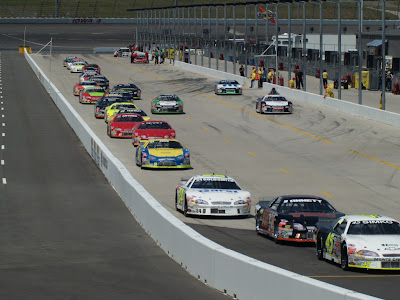This is the last installment from the Iowa Speedway weekend. The final race, pictured here, is of the NASCAR East and West championship series. The first picture is for Walt--37 was packing.
More passing action to the entrance of Turn Three. These pictures were taken with the E-1 and 14-54 Zoom.

Photographing from Turn Three. I wasn't very pleased with the tires sitting there and didn't like my options as far as "escape path" was concerned. A few minutes after this photograph was taken, a safety crew came by and shoo'd us out of the tires. Duh. Worse part is that any mass multicar accident on the backstretch would result in an impact right into that concrete barrier.

The catch-fence fully circles the track and there are several cutouts for photographers. Two cutouts are for television cameras and are quite long, but occupied by that huge lens pictured in the previous post. The rest of the cutouts have these nifty drop gates. They're just a touch small and you have to straddle the steel support braces for the SAFER barrier. When a car impacts the wall you feel it. A high-speed impact will move the barrier a foot or so. Those are styrofoam blocks between the steel wall and the supports.

This cutout was on the exit of Turn Four. The previous dayI got a few shots from here, but the debris was pelting me pretty bad because the cars were running a lower line and the tire bits had more of a chance to get up in the air. Sunday's race, they were usually right up against the wall (and hitting it too), so the debris blew a little bit differently. Still, my face was speckled. All shots here were taken while wearing safety sunglasses. The below shot was the final pass for the lead. Kevin Harvick (white car) and Joey Logano were dualing the entire race.

Oops. You can go two-wide and three-wide in the corners, but four-wide means that something ugly is going to happen.

Race winner, Joey Logano doing a Polish Victory Lap.
It was a fun and productive weekend. I got to try out the new Tokina AT-X 100-300 F4 lens. Overall, it didn't do bad (as you can see in the above picture), but the number of "keepers" from it are limited. Most of the problem is due to the length and weight of the lens makes it harder to hold steady, but the push-pull zooming action means that you are constantly fighting focus. Most successful pictures from the weekend were taken with the 14-54.
When shooting with the 14-54, I used AF-C. Since the battery-grip was installed, the tracking/focus speed was spot-on. Rarely did the camera ever have a problem with focusing. Even when shooting from turn one, where there was a barrier between me and the action right up to where I would take the picture, the lens would snap into perfect focus the moment the panning motion cleared the barrier.




































